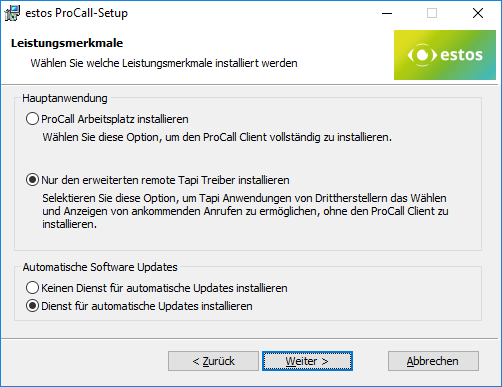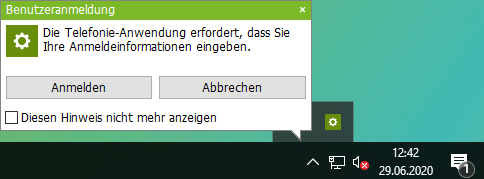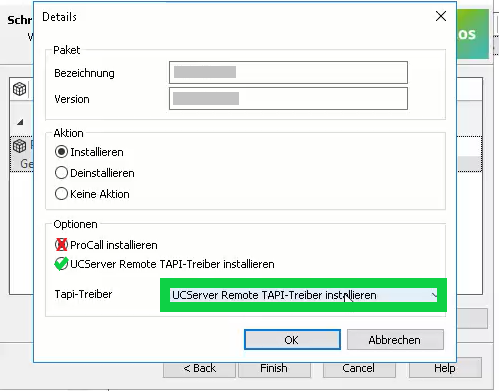TAPI Server 7 for TAPI-enabled applications such as CRM/ERP systems
November 2020. TAPI Server Version 7
The UCServer can be operated as a pure TAPI server. Only components of the UCServer are licensed for this purpose, which are exclusively intended for use with TAPI-capable applications and may not be used in conjunction with ProCall Mobile Apps, desktop applications (ProCall Clients) or the SDK. Parallel operation with new TAPI Server 7 licenses and ProCall Enterprise user licenses is possible.
TAPI Server 7 enables the pure control of telephone lines via the Remote TSP or the MultiLine TSP for Windows applications that use the Windows TAPI interface. This makes it possible to equip pure TAPI-capable applications such as CRM/ERP applications with simple CTI functions.
Application possibilities
- Dialing assistance directly from the CRM/ERP system: Establish calls by mouse click.
- Call acceptance directly from the CRM/ERP system by mouse click.
- Call signaling and contact resolution in the CRM/ERP system: TAPI server signals incoming calls to the CRM/ERP application and transfers the caller's number. This way, the CRM/ERP application can directly open the corresponding contact record or defined windows in the CRM/ERP system.
- Support for the telephone journal of the CRM/ERP application by transmitting the line status (free, busy, incoming calls).
Note
The usable functions depend on the performance of the respective TAPI-enabled application.
Note
The TAPI Server 7 can only be used in connection with a TAPI driver on the UCServer. A configured softphone does not deliver TAPI lines over the Remote TSP or Multiline TSP.
Installation instructions
Depending on whether the TAPI-enabled application is used in Windows client operating systems such as Windows 10 or in Microsoft Terminal Server environments/Citrix XenApp environments, the
or
for use.
Add license
Start the UCServer administration and add the purchased TAPI Server 7 license in the license area.
The license is not suitable for ProCall Client logins.
Installation Remote TSP without a client
The Remote TSP can be installed and made available to the clients in two ways:
- Manually by running the ProCall Windows .msi package on the client
- Update Server and estos Automatic Client Update
Manually on the client
Start the .msi of the ProCall Client for Windows on the Windows PC via ProCall_XXX.msi.
In the course of the setup select the option Install only the extended Remote TAPI driver at the installation step Line features.
Example screenshot: ProCall Setup "Install only the extended Remote TSP
Then follow the installation steps as usual and select the UCServer and log on to the UCServer. Further settings can be made after the installation is complete via the ProCall workstation settings (automatically executed after installation, otherwise found in the start menu).
After the installation is complete, the Windows client PC should be restarted. The TAPI-capable application is then provided with the lines CTIPrimaryLine and optionally CTISecondaryLine as TAPI lines. These represent the two first found controllable TAPI lines of a user or computer account and are configured as usual via the user administration of the UCServer or with the appropriate authorization (configure user account yourself) via the ProCall workstation settings.
The program TAPI Client Notifier was added to the system tray (systray or notification field) under Microsoft Windows and Autostart of the Microsoft Windows system.
Example screenshot: Prompt for credentials
This controls the login of the remote TSP to the UCServer.
Update service on the server
The update service can be installed on the Microsoft Windows client PC via the UCServer update server. In the UCServer administration, you can install the UCServer remote TAPI driver on selected computers via the update service in the computer administration.
In the installation wizard under Details, you must select the installation option Install UCServer Remote TAPI driver.

After the installation is complete, the Microsoft Windows Client PC should be restarted. The TAPI-enabled application is then provided with the CTIPrimaryLine and optionally CTISecondaryLine lines as TAPI lines. These represent the two first found controllable TAPI lines of a user account.
The program TAPI Client Notifier was added to the system tray (systray or notification field) under Microsoft Windows and Autostart of the Microsoft Windows system.
Example screenshot: Prompt for credentials
This controls the login of the remote TSP to the UCServer.
Installation MultiLine TAPI driver
The MultiLine TAPI driver is included in the download package of ProCall Enterprise in the Addons folder. Here you can find an installation guide as PDF.
Remote TSP error analysis
After installation, no TAPI lines are available to the third-party application.
Check the following before opening a ticket in Support:
- Are lines assigned to the user account? → Assign line
- Has the PC been restarted? → Restart the PC
- Is the remote TSP installed? → Check via Control Panel → Phone and Modem → Advanced
- Are CTIPrimaryLine or CTISecondaryLine displayed with the ephone.exe ? → Restart telephony service
Once the installation has been carried out again using the installation instructions and the error analysis , create a support ticket with a detailed description of what exactly was done to analyze the error, document this with screenshots and complete debug logs of the remote TSP that have recorded a system restart and the start of the ephone.exe.